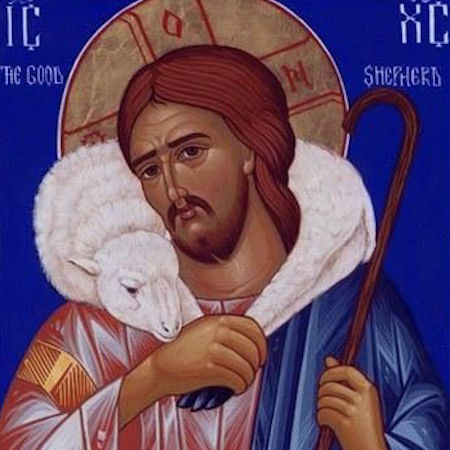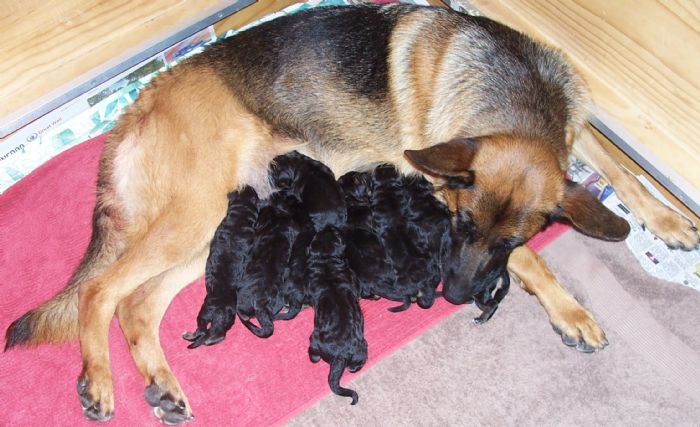A sermon on John 10:11-18, Psalm 23 & 1 John 3:16-24 by Nathan Nettleton
A video recording of the whole liturgy, including this sermon, is available here.
On this, the fourth week of the Paschal season each year, we hear the 23rd Psalm and some verses from the tenth chapter of John’s gospel. They are known as the Good Shepherd Readings, and some churches even describe this as “Good Shepherd Sunday”.
What sort of images come to your mind when you think of Jesus as the good shepherd? Stop and think about it for a moment.
I’d guess that the images that come to my mind are fairly common ones. There are two paintings that my mind seems to automatically link with the phrase “the good shepherd”. There are various versions of them, mostly not attributed to any particular artist, and they come both as icons and as more realist sentimental religious paintings.
In one picture Jesus is shown holding a small lamb cradled in his arms. In the other, which is usually associated with the parable of the lost sheep, Jesus is shown with a very relieved looking lamb on his shoulders. Both are rather idyllic pictures. The portrayal of cute little lambs rather than scraggy dumb old sheep ensures that Jesus is seen to be very tender and nurturing – a bit reminiscent of those prints you see around of the stripped to the waist muscular man tenderly holding a tiny baby against his chest.
Now there is nothing wrong with such an image of Jesus. He gave as plenty of reasons to see him as both tender and nurturing. But I’m not sure that tender nurturing cuddles with fluffy white lambs really does justice to the image of the “good shepherd”.
Think of images again. It’s often been said that Australia rides on the sheep’s back, so we should be able to come up with some local sheep herding imagery. What sort of images come to your mind when you think of Aussie sheep drovers? If your mind is running anything like mine, it is not images of cuddling fluffy white lambs that are popping into your consciousness now.
When we think of sheep herding here in Australia, we tend to think of dusty stations, tough farm hands on wiry horses or more likely now on motor-bikes or quad bikes, a few working dogs running this way and that, keeping the sheep in line. We tend to think of hot dry landscapes with flies as the most constant companion and perhaps a dingo lurking just out of sight waiting for a sheep to stumble and get isolated from the herd where it will be easy pickings.
It’s a scene of tough work done by hard people in a formidable environment. That may be the local sheep herding image, but does it contribute anything to a better understanding of the image of Jesus as the good shepherd? Actually, I think it might.
You see, when we look at the actual passages of scripture, they are not all cuddles and loveliness. Even in Psalm 23 we read of walking through the valley of death and finding in God a presence that enables us to overcome the fear that rises up in us in such a place. Perhaps it’s different for you, but for me it takes more than a cuddle to overcome my fear in the valley of death. In the valley of death, I want the presence of someone who can stand without flinching and take the worst that death can dish up but still come out on top.
Just over a week ago, when a man having a psychotic episode rampaged through a Sydney shopping centre with a knife, terrorising everyone and stabbing a number of people, mostly women, there were just a few people who didn’t run in panic, but stood in his way and tried to stop him. The one who got the most publicity was, of course, the Police Inspector who confronted him and when he turned on her, shot him. But of course, standing in the way of someone wielding a knife is a little easier when you’ve got a gun and are licensed to use it. Still terrifying, but at least the odds are in your favour.
Several other people before her also stood up to him without guns. One was a security guard who ended up getting stabbed himself, but who survived. And then there were two French tradies who have now become known as the “bollard men”, who tried valiantly to block his path and stop his progress armed with nothing more than a couple of bollards they’d picked up on the spot.
I don’t know about you, but I always find myself, in the aftermath of incidents like that, wondering what I would do in the same situation. Would I run, or could I be a bollard man? I’ve done some martial arts training, which always makes me feel a bit like I have a greater responsibility to act in situations of threat to others. And from my martial arts training, I know a few moves designed to disarm someone who is trying to stab you, but I also remember that the first thing we were taught about that was that the chances of success are quite low so it is to be attempted only as a last resort when you have no other way of avoiding the situation. I’d like to think I’d be one of the bollard men, but the truth is that I have no idea what I’d do in the heat of the moment in the midst of panic in the valley or shopping mall of death.
What is certain is that when we get into our gospel reading from John 10, the tough guy shepherd seems very clearly to be what the text is asking us to see. Our reading started at verse 11 and were told straight away that “the good shepherd lays down his life for the sheep.” So right up front we are talking about life and death situations, not just cuddling cute lambs. We are talking about a good shepherd who, like the security guard and the bollard men, will put their lives on the line to try to assure that the threat cannot reach the rest of us.
The image of the flock of sheep that operates in this chapter, the image of the rest of us if you like, is an image of a group in danger. There are wolves prowling about in the darkness waiting for an opportunity and there are thieves who will steal sheep if the shepherd lets down his guard. The only hope for the sheep in the midst of all this danger is the bollard man shepherd. And so Jesus is saying, when real danger threatens, you’d better have a reliable shepherd.
And what is Jesus’s idea of a reliable shepherd? One who will put the welfare and safety of the sheep before his own, as the bollard men did. One who will, should the unthinkable happen, give up his own life before he’d back down and let bushranger or dingo get at his sheep. The worker who’s only minding sheep to get a pay cheque is not going to put his life on the line for the sheep, although in Sydney last week, the paid security guard clearly did. But if they’re just sheep, then it’s just a job to the paid hand. In the face of real danger, such a worker will do exactly what the police say you should do when faced with dangerous armed robbers, give them whatever they ask for and don’t try to be a hero.
But Jesus says, “I am the good shepherd. I know my own and my own know me, and I lay down my life for the sheep.” And when you think about it, it is here that these two quite different images of shepherding begin to reconcile themselves to one another.
As the third reading from the first letter of John says, “This is how we know what love is – Christ laid down his life for us.” Sure, true love expresses itself in tender cuddles and other gentle expressions of affection, but as we know only too well, not everyone who offers affectionate physical intimacy is truly loving. Sometimes the one showing affection turns out to be exactly the dangerous predator that we need to be protected from, the very definition of a wolf in sheep’s clothing!
True love, while never devoid of displays of affection, is really known when the loved one is threatened with some danger. True love does not look all tender and cuddly in the face of a threat to the beloved.
Back before I had my first Australian Cattle Dog, I once had a German Shepherd dog, a breeding female, and I learned a lot about the good shepherd from her. She had a litter of pups, nine in all, but one of them was born dead. She trusted me normally and was always affectionate towards me, but she knew that when it came to her newborn pups, she knew what was good for them much better than I did.
As she gave birth, and in the first few days afterwards, she was never unhappy about me being in the room and watching her and her pups, but she wasn’t yet ready to let me touch them. And even when I tried to remove the dead pup from the whelping box, I nearly lost an arm. No one in their right mind argues with a snarling bare-toothed German Shepherd bitch protecting her pups, so the dead pup stayed there until she was prepared to concede that there was no hope for it. Once she did that, several hours later, she dropped it out of the box herself and was happy for me to remove it, but until she gave up hope for it, she loved it and would have defended it with her life.
Watch her with her pups when there was no sign of danger and she was all tenderness and nurture. The soft and cuddly good shepherd images fitted easily. Give her any reason to fear for the pups she loved and the other side of the good shepherd snapped to the forefront, ready to fight to the death before allowing danger close to her beloved ones.
Now that sounds like an image of a shepherd whose presence would give you courage when you have to walk through the valley of death.
“This is how we know what real love is – Christ, the good shepherd, laid down his life for us.”







0 Comments